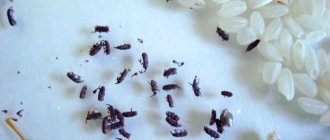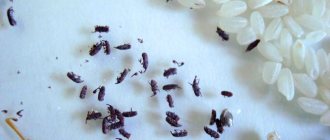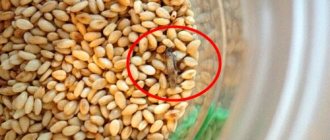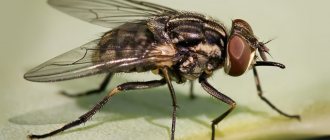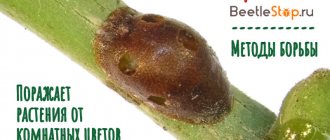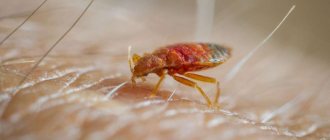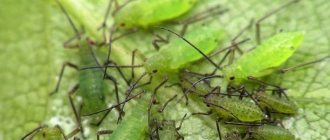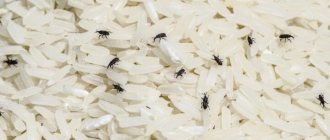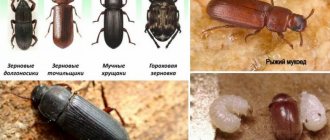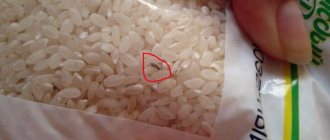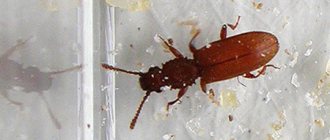Causes of insects
Where do insects come from in kitchen cabinets? Little lovers of cereals and flour live only in these products. They have nothing to eat outside, so it is impossible to bring beetles from there. They won’t fly into the window or crawl away from their neighbors because they don’t travel long distances. The only reason why bugs appear in cereals is poor quality processing by the manufacturer.
If the manufacturer of bulk products neglects the standards for the production and storage of cereals, poorly processes the goods before packaging, insect larvae end up in stores, and from there - in kitchen cabinets. Most often, insects can be found in cereals sold by weight, but sometimes they are also found in hermetically sealed packages.
As soon as even one package of contaminated product appears in the kitchen, an insect invasion soon occurs. From the larvae present in the cereal, bugs hatch, which quickly spread and multiply.
Eating methods
Rice weevils feed on grain crops:
- buckwheat;
- beans;
- rice;
- barley;
- rye;
- wheat and others.
Insects also develop in bakery and pasta products. According to studies, adult individuals are capable of destroying up to 30% of the crop. Weevils damage grains at all stages of development. Moreover, these insects are dangerous not only because they eat crops.
During their life, weevils leave substances in the grains that cause allergic reactions in a susceptible person. Beetles are also considered carriers of fungal infections. And the larvae contain substances that provoke the development of tumor processes and stop tissue regeneration.
Is it dangerous to eat food contaminated with bugs?
If there are bugs in the cereal, you should not eat it. It is better to throw away all contaminated products or feed them to birds and animals. If such waste is beyond your means, the products must be thoroughly cleaned. It is better to sort the cereal by hand and sift the flour through a fine sieve.
After there are no visible insects left in the cereal, it must be thermally treated:
- Heat in the oven . Flour and semolina cannot withstand heating above 50°C. Other cereals can be heated to 100-110°C. Processing time – 30-40 minutes.
- To freeze. Place the sorted grains into bags and close them tightly. Place in the freezer for 2-3 days. In winter, you can put the cereal on the balcony or in the courtyard of a private house.
- Keep it in the sun. Spread the product in a thin layer on a baking sheet and place in direct sunlight for several hours.
If you plan to make porridge from the contaminated product right now, you can fill it with salted water. After some time, all the pests will float to the surface.
Important! Even if there are no adults in the croup, white larvae, scales, and insect waste products invisible to the eye will remain in it. To eat or not to eat such a product is rather a matter of disgust. However, it should not be given to young children, elderly people or those with weakened immune systems. Pest residue may cause an allergic reaction.
Is it possible to eat contaminated cereals and flour?
Some people are disgusted to even touch such a product, let alone consume it, because we are talking about health. It is not recommended to use spoiled cereals for making porridge.
Even after washing, eggs, larvae, their husks and excrement may remain. All this will not bring any benefit; moreover, it can cause unpleasant consequences in the form of poisoning or allergies.
It's a little easier with flour. Using a fine sieve can get rid of all this debris. The final disinfection of flour is carried out using an oven at a temperature of +50 °C.
Pest prevention
There are many ways to get rid of bugs in cereals in the kitchen. However, this cannot be done forever. There will always be a possibility of buying a low-quality bulk product again.
To minimize the risk, preventive measures should be followed:
- Purchase products only from trusted manufacturers . Preference is given to sealed plastic packaging. Do not buy bulk cereals that appear to be of obviously poor quality.
- Buy groceries only for a short period . It's good to have supplies of essential goods. But in completely filled kitchen cabinets, there is a higher risk that bugs will fill all the packs, which then have to be thrown away.
- Use storage containers . Glass jars that close tightly for bulk products are the best option. They will not protect against the appearance of pests, but will not allow them to spread beyond the container. As a last resort, open bags should be closed with a paper clip or clothespin and tied with an elastic band.
- Conduct regular audits. Once a month, it is advisable to sort through existing food supplies and throw away what has become unusable. Something that has been lying around for a long time, but is still suitable, should be consumed first.
- Do the cleaning. Crevices and corners of cabinets clogged with crumbs and food residues are cozy places for pests. Keeping your kitchen clean is an important preventative measure.
To repel insects, you can put fabric bags and sachets with aromatic herbs and spices in the closet. Lavender, wormwood, nutmeg, and cloves are suitable.
Where can I find
Insects live in various foods and love flour and pasta.
Crackers
Bread grinders, which are light brown in color, live in bakeries. Such bugs fly well, hide under the windows in the apartment and gobble up crackers.
Cookie
Tiny insects love straws and are found in drying biscuits. In both a small store and a supermarket you can buy gingerbreads and baked goods, cookies with worms. Such guests appear during long-term storage in the kitchen.
Nuts
Under favorable conditions, food moths begin to multiply. It is not poisonous, but spreads quickly, lays eggs, from which larvae crawl out and adore walnut kernels.
Dried fruits
Compotes rich in vitamins are made from prunes, dried apricots, and apricots. But if the harvesting technology is violated or the storage rules are not followed, dried fruits are attacked by microscopic moth caterpillars.
Food Ingredients
The products contain carbohydrates, fats, proteins, which are necessary for the normal functioning of the body. Insects look for food in different food components.
Bread
Not all mini-bakeries follow the technology for baking loaves and other products. And if the norms are violated, bugs crawl from contaminated flour into damp bread.
Beans
In legumes, weevils appear not only due to improper storage; the parasites attack the plants even in the garden before harvesting. If at least one bug is detected in the beans, they are sent to the freezer or hot oven.
Tea coffee
You can bring grinders from the store into closed cabinets where spices and grains are stored, but moths love not only dried fruits. Insects are not averse to eating tea, cocoa, and coffee beans.
Flour
Bugs that get into the kitchen begin to feed on bulk products and spices. At mills, flour is obtained from wheat, rye, and corn, which is packaged in bags and packages and delivered to stores or warehouses. You can buy such a product already with bugs.
Vegetables
In recent years, a lot of pests have appeared in the fields. To cope with insects, crops have to be sprayed. But if cucumbers, cabbage or tomatoes are stored in improper conditions, they begin to rot and worms and beetles appear.
Furniture
Grinders take up residence in old sofas, chairs, and wooden floors. Insect larvae feed on wood, making passages in it.
Appliances
Cockroaches take up residence in a microwave oven, an electric meat grinder, a gas stove, and even in a refrigerator, and they are not easy to get rid of.
Insects grow and reproduce quickly, but you need to fight them in your apartment carefully so as not to harm your household
Hard to reach places
Even clean housewives have bugs in the kitchen, which are difficult to remove because they hide in cracks, in ventilation, and crawl under the bathtub. The springtail insect eats the roots of flowers, climbing deep into a pot of soil.
Types of kitchen bugs
There are several types of small bugs in the kitchen:
| Name | Peculiarities | Where does it start? |
| Bread grinder (pharmacy beetle, leather beetle) | Common type. Little brown bugs. Can fly | Flour products, pharmaceutical plants, books, tea, coffee, grain mixtures |
| Flour beetle | A small black bug with horns. Prolific. Even a sieve will not help with eggs in flour - they are too small | Flour, semolina, starch, dried fruits, bran, cereals: buckwheat, rice, oatmeal |
| Red mukoed | A red oblong bug with long horns. Enters the house with low-quality animal feed | Cereals, grain products, flour (especially old) |
| Suriname mucoed | Similar to the red mule eater, but lighter in color | Flour, grain, cereals |
| food moth | A flying insect similar to a common moth. The only kitchen pest that enters the house not only with low-quality products, but can also fly through ventilation or a window | Dried fruits, pasta, tea, cereals: buckwheat, rice, semolina, rolled oats |
| Rice weevil | An oblong bug in rice, from a distance it resembles an ant. Can fly. Breeds in warmth | Solid cereals: rice, buckwheat, pearl barley |
| Bean grain | An oval-shaped bug with a pattern on the back. Found mainly in legumes | Legumes: beans, peas, lentils, chickpeas, beans, soybeans. Can eat solid cereals |
What unites bugs in the kitchen is that they all multiply quickly and are difficult to remove.
Reproduction
Rice weevils reproduce in grain, making holes in the seeds, where they lay up to 300-500 eggs at a time. This stage of development takes 6-9 days, after which the larvae appear. In the middle latitudes of Russia, no more than two generations of insects appear, in the southern latitudes - up to eight. Thanks to this fecundity, the rice weevil is able to displace the granary variety of beetles from the house.
Sexual dimorphism
Weevils are characterized by sexual dimorphism, in which external differences are observed between females and males. The latter are distinguished by their smaller size, compact rostrum and closely spaced antennae. The tibiae of males are more curved, and there are tubercles on the surface of the elytra.
Larva
The development of larvae stops if the ambient temperature drops to +4 degrees. This phase of beetle development takes up to three weeks. The length of the larvae reaches 3 mm (in granary weevils). At this stage, insects feed on rice, in which the female has laid eggs. The larvae are able to eat up to 70% of the initial mass of grains.
Doll
After three weeks, the larva pupates, first becoming white and then yellow. After 7-10 days (provided that the air temperature remains at +12 degrees and the humidity level does not exceed 8%), an adult is born that lives no more than six months.
How to get rid
Getting rid of kitchen pests is not an easy process and requires an integrated approach. The first thing to do is to find the source of the infection and get rid of it. Conduct an audit of all products. Throw away or sort out spoiled ones. Clean, wash, clean out the entire kitchen and cabinets. Then use one of the industrial or home remedies for treatment.
Folk remedies
To remove pests, the following folk remedies will help:
- Vinegar. Wash the inside of cabinets and all kitchen surfaces, including the floor, with hot water and vinegar. Treat corners and crevices especially carefully.
- Laundry soap . Dark, with a high percentage of fatty acids content is suitable. Grate and dissolve in a bucket of hot water. Use for cleaning furniture and floors.
- Borax. Mix with powdered sugar or flour. You can add raw egg, honey. Spread the mixture on flat lids or sheets of paper and place it in the beetles’ habitats. They will eat the bait and bring it with them to the colony, poisoning themselves and poisoning others.
- Vegetable oil . Place small dishes with vegetable oil in places where beetles accumulate. They will taste the oil and drown in it. The oil needs to be changed periodically.
It is believed that bugs in cereals do not like the strong smells of bay leaves, lavender, garlic, wormwood, and nutmeg. It is recommended to arrange containers and lay out bags with these products. However, there is no guarantee that odors will repel absolutely all types of bugs.
This is interesting:
How, where and for how long you can store pasta.
Is it possible to freeze kombucha and how to properly preserve it until next summer.
Secrets of proper storage of yeast dough.
Chemistry to help
Getting rid of pests using folk remedies is a rather long and labor-intensive process. This can be done much faster using special chemicals, but you need to be extremely careful with such drugs, avoid contact with skin and inhalation, and thoroughly ventilate the room.
The following remedies are effective:
- Chlorine-containing preparations (Domestos, Belizna, etc.). Wash all cabinets, shelves, walls and floors in the room with water containing chlorine. Leave all doors open and ventilate the kitchen for several hours. Repeat treatment every other day.
- "Anti-bug." Preparation for insecticidal treatment of wooden surfaces. The effect of the product is not only powerful, but also long-lasting. There is no threat of reappearance of pests for a long time.
- “DALI anti-ant” produced by Rogneda. Despite the name “anti-ant”, the drug is also effective against any insects, including bugs in flour.
- "Dichlorvos". One of the most effective remedies. Spray the kitchen with an aerosol and close it for half an hour. After this, open the windows and doors, turn on the hood and ventilate thoroughly. It is better not to stay in the treated area during the day, even after ventilation.
If folk remedies and store-bought preparations do not help remove uninvited guests from the kitchen once and for all, there is one last method. It is necessary to call a team of specialists involved in treating premises from pests. But in this case, you need to leave the apartment for a while. It is better not to enter the house for at least a day after treatment.
Important! Health and safety must be taken into account when treating your kitchen with chemicals. Remove all food products and indoor plants from the premises, and remove children and pets from the apartment during treatment. Wear gloves, long sleeves, a respirator or a medical mask. After treatment, thoroughly ventilate the room.

